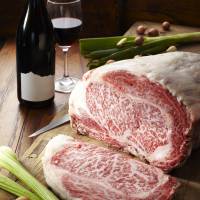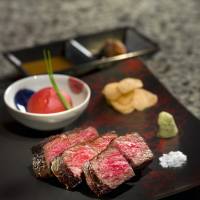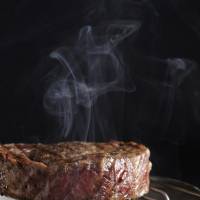The sizzle and the smell whet your appetite. Take a bite, and you’ll find the flavorsome meat literally melting in your mouth. Welcome to the world of Kobe beef that has captured the palates and hearts of gourmands over the years as the world’s choicest beef.
History of Kobe beef
Until the late 19th century, consumption of meat from any kind of four-legged animal, let alone cows, was strictly prohibited in Japan. This all changed in 1868, however, as the country opened up to the world under the Meiji Restoration. Shunning the conventional, traditional value system of the Tokugawa Shogunate that prevailed until then, the changes under the restoration allowed an Englishman to obtain a cow from the local farmer to eat. Eating beef from a foreign country can be difficult due to differences in cattle, but the man found the beef surprisingly good. Word quickly spread — particularly among foreign residents — that the beef from the Kobe-Tajima area was tender and delicious. Under the name of “Kobe beef,” it began being exported to Europe and America. Due to such a unique background in modern history, Kobe beef is still a relative newcomer on the dietary chronology of mankind.
Turning to the broad categorizations of beef, two kinds of beef are generally considered to exist in Japan: wagyu (Japanese beef) and kokusan-gyu (beef from all cattle raised in Japan). Wagyu is further divided into the four breeds of black, brown, polled and shorthorn. Tajima-gyu from which Kobe beef is produced, comes from the black breed. Kokusan-gyu refers to all cows raised domestically in Japan. This means that, regardless of what country the cow is from and what breed it is, a cow is classified as being kokusan-gyu if it has spent more than half of its life in Japan.
Certification and cost
Delving further, Kobe beef specifically refers to meat from Tajima-gyu cows certified by the Kobe beef Distribution and Promotion Council. The bloodline of the purebred seed-stock cattle of Tajima-gyu cows has been maintained in Japan since the 17th-century Edo Period. The long, untarnished lineage of Tajima-gyu has ensured the high quality of beef produced today. Raising cattle for the production of this high-end comestible requires a great deal of care and time, adding to the cost. Furthermore, the total amount of Kobe beef produced accounts for a mere 0.16 percent of the total beef that is distributed for consumption. Overall, such conditions as a whole make Kobe beef more expensive.
Only virgin cows or gelded bulls raised to maturity can become Kobe beef. Additionally, there are three more prerequisite conditions for beef to be officially certified as Kobe beef. One is that the gelded bull or virgin Tajima-gyu cow must be born in Hyogo Prefecture from a Tajima-gyu cow having a pure lineage. Second is that the gelded bull or virgin cow must be bred and raised by a designated farmer in the prefecture. Finally, the animal must be slaughtered at one of the slaughterhouses in the prefecture. On top of that, the beef must pass a strict beef marbling standard grading test, weight limitations and other criteria and examinations. Owing to such a rigid quality-control system that is guaranteed by the 10-digit identification number attached to the meat at the butchers and restaurants, you can tell the cow’s specific lineage, its place of birth and raising, its market and its certified grade as Tajima-gyu Kobe beef.
From a flavor perspective, fine-tasting Tajima-gyu Kobe beef is further known to have a good balance of sashi and shimofuri. Sashi is the fatty content of the scarlet-colored muscle fiber, and is classified into two categories of coarse and fine. Shimofuri refers to the cut having a high degree of fat marbling.
Global fans
Owing to such stringent control over its breeding, rearing, butchering and production processes, Kobe beef is enjoyed by numerous celebrity gourmets from around the world as a gastronomic experience that cannot be missed when visiting Japan. More recently, then-U.S. President Barak Obama was known to specifically order Kobe beef upon his Japan visit in 2009. Various royal family members, as well as Hollywood stars and other celebrities, have also known to be enchanted by the aroma, taste and texture of Kobe beef. In fact, they are said to be so taken with Kobe beef that today’s fans are making incognito visits to Tajima-gyu cattle farms to find out how the cows are actually raised.
Although Kobe beef has inspired the most talented and skillful of chefs to create unforgettable gourmet experiences, “I personally think the best way to savor and appreciate it is to serve it simply, and enjoy the rich flavor and umami of the meat itself,” says Japanese food coordinator Suzume Kurihara. Because of its full-bodied fattiness, her recommendation is to “appreciate the true taste of the meat itself with a sprinkling of natural salt and wasabi.”
Whichever way it is served in any cuisine, another tip for enjoying Kobe beef to a fuller extent is to consume it together with the highest-quality Japanese sake; perhaps a chilled glass of “dai-ginjyo” from the Kobe area that is also known for producing some of the best sake in Japan. High-quality, clean water is said to be needed for both good Kobe beef and fine sake, making sake from Kobe an ideal pairing.
A must-try, Kobe beef is sure to open a new door to your wining and dining experience.

 Click to enlarge
Click to enlarge


